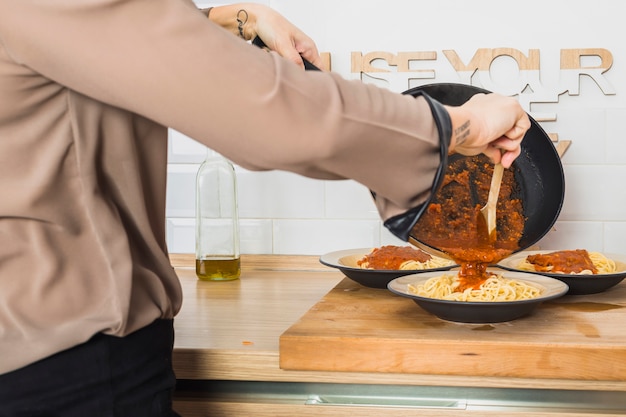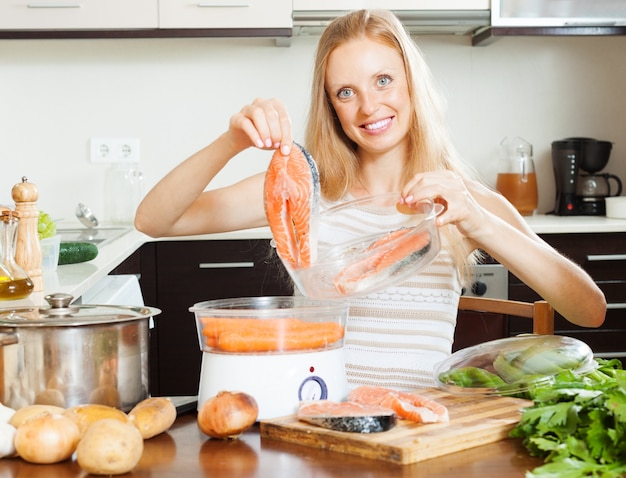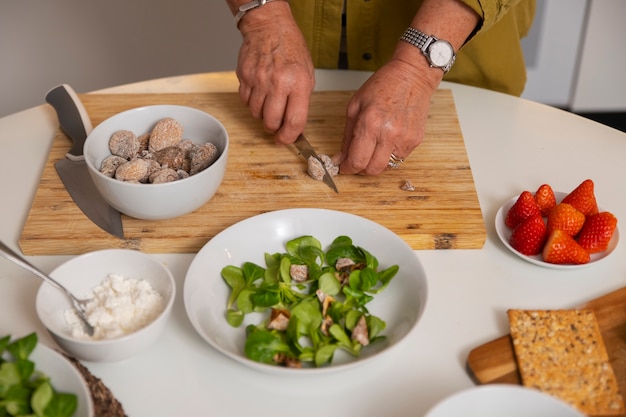There’s something magical about a plate of steaming crab legs. That rich, salty aroma, the satisfying crack of the shells, and the succulent, sweet meat… it’s pure culinary bliss! But let's be honest, we don’t all have the luxury of a coastal escape for fresh catches. So, I’m here to share my secrets for achieving that restaurant-quality crab leg experience right in your own kitchen. No fancy equipment, just simple techniques and a dash of enthusiasm. Trust me, you won’t regret it!(Part 1)
The Star of the Show: Choosing Your Crab Legs

The journey to incredible crab legs begins with selecting the perfect ones. Over the years, I’ve learned a few tricks of the trade, and I’m thrilled to share my wisdom with you.
Fresh is Best (But Not Always Possible)
If you're fortunate enough to live near a bustling seafood market or have a trusted fishmonger, fresh crab legs are the holy grail. Their sweet, delicate flavour is simply unmatched. It’s that fresh-from-the-ocean taste that makes your tastebuds sing! But let's be real, this isn’t always a possibility for everyone.
Frozen: Your Reliable Option
Don’t dismiss frozen crab legs. They're a fantastic alternative and incredibly convenient. Just make sure you pick a reputable brand and check the packaging for quality. Look for frozen legs that are individually wrapped for optimal freshness. You’ll be surprised by how delicious they can be!
types of crab legs
The world of crab legs offers a variety of options, each with its unique flavour and texture. Here's a rundown of some popular types:
- King Crab: These are the heavyweights, with impressive, chunky legs. They're known for their succulent meat and slightly sweet flavour. A true indulgence!
- Dungeness Crab: A classic choice, boasting a delicate, sweet flavour and a firm texture. They’re often considered the "gold standard" for crab legs.
- Snow Crab: Often a more budget-friendly option, snow crab has a sweeter, lighter flavour than king crab. It’s perfect for a casual, weeknight feast.
Size Matters
For a truly satisfying crab leg experience, choose larger legs. They'll have more meat, making it easier to extract and enjoy. You'll be less frustrated and have more of that delicious goodness! However, smaller legs are perfect for a quick meal or if you're working with limited space in your steamer.
(Part 2)

Prepping Your Crab Legs

Once you have your crab legs, it’s time to prepare them for their culinary transformation. A little prep work goes a long way in ensuring a tasty and mess-free experience.
Thaw (If Necessary)
For frozen crab legs, thawing is a must. I prefer a slow and gentle method like transferring them from the freezer to the refrigerator overnight. This helps prevent them from becoming soggy. If you're in a pinch, you can thaw them in a bowl of cold water, but be careful not to overdo it, as this can affect the texture.
Rinse and Clean
Whether fresh or frozen, give your crab legs a good rinse under cold running water. This removes any excess debris or dirt, ensuring a clean and healthy meal.
Splitting (Optional but Recommended)
Splitting the crab legs lengthwise makes them easier to eat and prevents them from curling up during cooking. Use a heavy knife or kitchen shears to cut the legs in half. This is a simple yet effective trick that enhances the eating experience.
(Part 3)
Cooking Up a Storm: Your Crab Leg Journey
Now comes the fun part – cooking your crab legs! There are several methods to choose from, each offering a unique flavour and texture. I'll share my favourite techniques, along with tips to achieve perfection.
Steaming: The Classic Approach
Steaming is my go-to method for cooking crab legs. It results in tender, succulent crab meat with a delicate flavour.
What You'll Need
- A large pot with a steamer insert
- Water
- Lemon slices (optional)
- Fresh herbs (optional, such as bay leaves, thyme, or parsley)
Steaming Instructions
- Fill the pot with about an inch of water.
- Add lemon slices and fresh herbs (if desired) to the water for an extra layer of flavour.
- Bring the water to a boil over high heat.
- Place the crab legs in the steamer basket. Ensure they are not overcrowded to ensure even cooking.
- Cover the pot and steam for 10-15 minutes, depending on the size of the crab legs. Larger legs may require slightly longer cooking time.
- Test for doneness by inserting a fork into the thickest part of the leg. The meat should be opaque and easily pull away from the shell.
Boiling: A Quick Option
Boiling is a faster method than steaming, although it won't produce the same delicate flavour. It's a good option if you're short on time or prefer a more intense crab flavour.
What You'll Need
- A large pot
- Water
- Salt (optional)
- Lemon slices (optional)
- Fresh herbs (optional, such as bay leaves, thyme, or parsley)
Boiling Instructions
- Fill the pot with enough water to cover the crab legs.
- Add salt, lemon slices, and fresh herbs (if desired) to the water.
- Bring the water to a rolling boil over high heat.
- Carefully lower the crab legs into the boiling water. Be cautious of steam and splashes!
- Reduce the heat to a simmer and cook for 8-10 minutes, or until the meat is opaque and easily pulls away from the shell.
(Part 4)
Grilling: A Smoky Twist
For a smoky, more intense flavour, grilling your crab legs is a fantastic option. It adds a delightful char and a touch of smokiness that elevates the flavour profile.
What You'll Need
- Gas or charcoal grill
- Aluminum foil
- Butter
- Lemon wedges
- Garlic (optional, minced or in cloves)
- Fresh herbs (optional, such as thyme, rosemary, or parsley)
Grilling Instructions
- Preheat your grill to medium-high heat.
- Place a large piece of aluminum foil on the grill grates. Make sure it’s large enough to wrap the crab legs.
- On the foil, place the crab legs, lemon wedges, garlic (if desired), and fresh herbs (if desired).
- Dot the crab legs with butter. A generous amount of butter will add richness and flavour.
- Fold the foil over the crab legs to create a sealed packet. This helps trap the steam and moisture, keeping the crab legs tender and juicy.
- Grill for 10-15 minutes, or until the crab meat is opaque and easily pulls away from the shell.
Baking: A Simple Option
Baking is a convenient and fuss-free way to cook crab legs. It’s ideal for when you want to make a large batch for a crowd.
What You'll Need
- A baking sheet
- Aluminum foil
- Butter
- Lemon wedges
- Garlic (optional, minced or in cloves)
- Fresh herbs (optional, such as thyme, rosemary, or parsley)
Baking Instructions
- Preheat oven to 400°F (200°C).
- Line a baking sheet with aluminum foil.
- Place the crab legs on the foil, along with lemon wedges, garlic (if desired), and fresh herbs (if desired).
- Dot the crab legs with butter.
- Bake for 15-20 minutes, or until the crab meat is opaque and easily pulls away from the shell.
(Part 5)
Serving Your Crab Leg Masterpiece
Now, the moment you’ve been waiting for – serving your perfectly cooked crab legs! Here’s how to make it a truly memorable experience.
The Essential Tools
You’ll need a few essential tools for cracking open those shells and extracting the succulent meat.
- crab crackers: These are specially designed tools with a blunt side for cracking and a pointed side for extracting meat. They are your trusty companions for tackling those stubborn shells.
- Crab Forks: These small, slender forks are perfect for picking out the delicate crab meat. They provide a gentle and efficient way to retrieve every last bit of meat.
Sauce Sensations
No crab leg feast is complete without a delightful sauce to complement the sweet and salty flavours. Experiment with these classics:
- Melted Butter: The classic choice, simply irresistible! The richness of butter perfectly enhances the crab’s natural flavours.
- Garlic Butter: Add a clove of minced garlic to melted butter for a flavour boost. A touch of garlic adds a savory complexity.
- Lemon Butter: Squeeze a lemon wedge into melted butter for a refreshing twist. The tang of lemon cuts through the richness and adds brightness.
- Cocktail Sauce: A classic combo of ketchup, horseradish, and lemon juice. This spicy and tangy sauce is a timeless favourite.
- Spicy Mustard Sauce: Mix Dijon mustard with a pinch of cayenne pepper for a fiery kick. This sauce adds a touch of heat and zest.
side dish Starpower
Complete your crab leg spread with some delicious side dishes that complement the main attraction.
- corn on the cob: A classic pairing, offering a sweet and contrasting flavour. The sweetness of corn balances the saltiness of the crab.
- Coleslaw: A refreshing and tangy accompaniment. The creamy, tangy coleslaw provides a delightful counterpoint to the rich crab meat.
- potato salad: A creamy and comforting side dish. The creamy potato salad adds a comforting element to the meal.
- Baked Bread: For soaking up all those delicious juices. A crusty bread is perfect for dipping into the melted butter or sauce.
(Part 6)
The Art of Cracking and Enjoying
Now, let’s talk about the fun part: cracking those crab legs and savouring that juicy meat. It’s a bit of a ritual, and once you get the hang of it, it’s surprisingly easy.
Cracking the Code
- Find the Crack: Look for the natural seam running down the length of the leg. This is where the leg splits naturally.
- Crack It Open: Use your crab cracker to firmly crack the leg along the seam. You’ll hear a satisfying snap.
- Extract the Meat: Use your crab fork to gently pull the meat out of the shell.
- Don't Forget the Knuckles: The knuckles contain some of the sweetest meat. Use your crab fork to pull it out. You’ll be rewarded with a burst of deliciousness!
Dip It, Savor It, Repeat
Dip your crab meat in your chosen sauce, and prepare for a flavour explosion. The combination of sweet, salty, and tangy will leave you wanting more.
(Part 7)
Crab Leg Leftovers: Second Chance at Deliciousness
Don't let those leftover crab legs go to waste! They can be used to create a variety of delicious dishes.
Crab Salad
Simply flake the leftover crab meat, mix it with mayonnaise, chopped celery, red onion, and a touch of lemon juice. Serve it on crackers, in lettuce wraps, or on toasted bread. A delightful and refreshing way to use up leftovers.
Crab Rangoons
Combine leftover crab meat with cream cheese, chopped green onions, and soy sauce. Wrap the mixture in wonton wrappers, deep-fry until golden brown, and serve with your favourite dipping sauce. A fun and flavorful appetizer or snack.
Crab Omelette
Stir leftover crab meat into a classic omelette for a protein-packed breakfast or brunch. A simple and satisfying way to incorporate crab into a different meal.
Crab Soup
Flake the leftover crab meat and add it to a creamy soup base for a flavorful and satisfying meal. This creates a hearty and comforting soup.
(Part 8)
FAQs: Your Crab Leg Queries Answered
Here are answers to some common questions about cooking and enjoying crab legs.
1. How long can I keep crab legs in the fridge?
Fresh crab legs can be stored in the refrigerator for 1-2 days. Frozen crab legs can be stored in the freezer for up to 3 months.
2. How can I tell if crab legs are bad?
If the crab legs have a strong, fishy smell, a slimy texture, or a discolored appearance, they’re likely not safe to eat. It's always best to err on the side of caution when it comes to seafood freshness.
3. What’s the best way to store leftover crab legs?
Store leftover crab legs in an airtight container in the refrigerator for up to 3 days.
4. Can I freeze leftover crab meat?
Yes, leftover crab meat can be frozen for up to 3 months. Just make sure to wrap it tightly in plastic wrap or aluminum foil to prevent freezer burn.
5. What are some good ways to use leftover crab meat?
Leftover crab meat can be used in a variety of recipes, including salads, dips, soups, and pasta dishes. Just let your imagination run wild!
(Part 9)
Conclusion
There you have it – my guide to perfect crab legs at home! It's a simple yet satisfying journey that will leave you with a delightful feast. Don't be afraid to experiment with different cooking methods, sauces, and side dishes to find what you love best. Remember, the most important ingredient is a little bit of passion and enjoyment. Enjoy your crab leg extravaganza!
Everyone is watching

How to Cook Frozen Lobster Tails Perfectly: A Step-by-Step Guide
RecipesLobster. Just the word conjures up images of lavish meals, special occasions, and a taste of luxury. But let's...

Pigs in a Blanket Cooking Time: How Long to Bake for Perfect Results
RecipesAh, pigs in a blanket. Just the name conjures up images of those delightful little parcels of crispy pastry en...

Pork Fillet Cooking Time: How Long to Cook It Perfectly
RecipesPork fillet, or tenderloin as it's sometimes called, is a real favourite in our house. It's so versatile, and...

The Ultimate Guide to Tender, Juicy Pulled Pork
RecipesRight, let's talk pulled pork. It's one of those dishes that just screams "comfort food," doesn't it? I mean...

The Ultimate Guide to Cooking Delicious Frankfurters
RecipesLet's face it, we all love a good frankfurter. It's a classic, simple, and always satisfying. But let's be rea...
